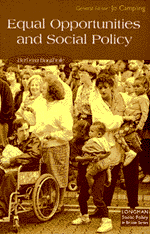

![]()
![]()

This volume is a very good and well up to standard addition to an already successful series. Bagilhole's presentation of equal opportunities issues as they apply to women, Blacks and disabled people is eminently clear, with, in Part I of the book, an exemplary presentation of the complexities of meaning and politics embedded in the term 'equal opportunities'. Part I also presents a well informed account of the history and problems associated with legislation for equal opportunities in Britain since the second world war, and takes in the impact of the European Union on British legislation in this area. What could be somewhat heavy going (there is a lot to get through) turns out to be a surprisingly easy read since Bagilhole's style is lively and clear. The central question of how far the structure of opportunity can be altered by legislation is discussed, although, for my taste, a little too briefly.
Part II of the book turns to the extent of equal opportunities for women, Blacks and disabled people within the core areas of social policy: education, employment, income maintenance, social services, health services and housing. Each service is tackled in turn and the success or otherwise in terms of equal opportunities in relation to the three identified groups is reviewed. This is done very consistently for each group, and there is a certain mechanical quality in the way the position of women, Blacks and disabled people is addressed in turn in each chapter. Inevitably some of the evidence presented rehearses well trodden ground, but Bagilhole's depth is impressive, and I found myself marking the bibliography with numerous asterisks as reminders to read items which sound very interesting and which I have not before encountered.
In such an exhaustive text which is trying to look at such a wide range of services there are moments of distinct speed when I would have preferred a rather more ruminative approach. The central argument that, as her opening sentence puts it, 'The idea of equal opportunities is at the core of social policy' is perhaps a little lost in the core of the text, but the idea of looking at social policy through this perspective nevertheless works well and will provide a very useful introduction to the core issues of allocation and discrimination within social policy in general, and by particular social services.
My main criticism of the book is that there is only a limited sense of where the issue of equal opportunities and social policy is going, how relevant it is likely to remain in the social policy of the future and where the main issues, using this perspective, are likely to arise. This limited vision is partly driven by the demands of a student text, but it also arises out of the careful separation of the three groups of disadvantaged people whom she identifies, and a consequent muted attention to the way in which their interests may conflict and, indeed, drive continuing negative discrimination. For example, the commentary of disabled writers such as Oliver and Morris is used to critique the professional, medicalized model of disability, but much of that model, in terms of provision, is actually delivered by women. No doubt Bagilhole would argue (indeed she does argue) that women delivering services at the coalface are managed by men in power, but there is a limited sense of how management within health and social care organisations is itself changing, or how some women and Blacks have achieved managerial positions within them and may, as managers, begin to perpetuate the unequal opportunities Bagilhole critiques.
In short, this is a book with more than adequately maps a territory and it will be of considerable use to teachers and students. What we need now is deeper look at how the terrain is changing, and an evaluation of the factors, including but not only equal opportunities legislation, which are the determinants of that change.
Clare Ungerson
University of Southampton